In this article, you’ll find my top picks for triathlon wetsuits.
We’ll take a deep dive into the fascinating world of wetsuit technology, design, and comfort. Whether you’re a seasoned triathlete searching for a suit that can revolutionize your performance or a beginner looking for the perfect first wetsuit, we have something that will meet your needs.
Our Top Pics
Here is my overview regarding the best triathlon wetsuits
- Best overall: Synergy Triathlon Wetsuit 3/2mm full-sleeves
- Best no-sleeves: Synergy Triathlon Wetsuit 3/2mm no-sleeves
- Best no-sleves on a budget (men): O’Neill Men’s O’Riginal 2mm
- Best for intermediate: Synergy Endorphin Full Sleeve Smoothskin
- Best wetsuit shorts: Wetsuit Buoyancy Shorts
Synergy Triathlon Wetsuit 3/2mm full-sleeves
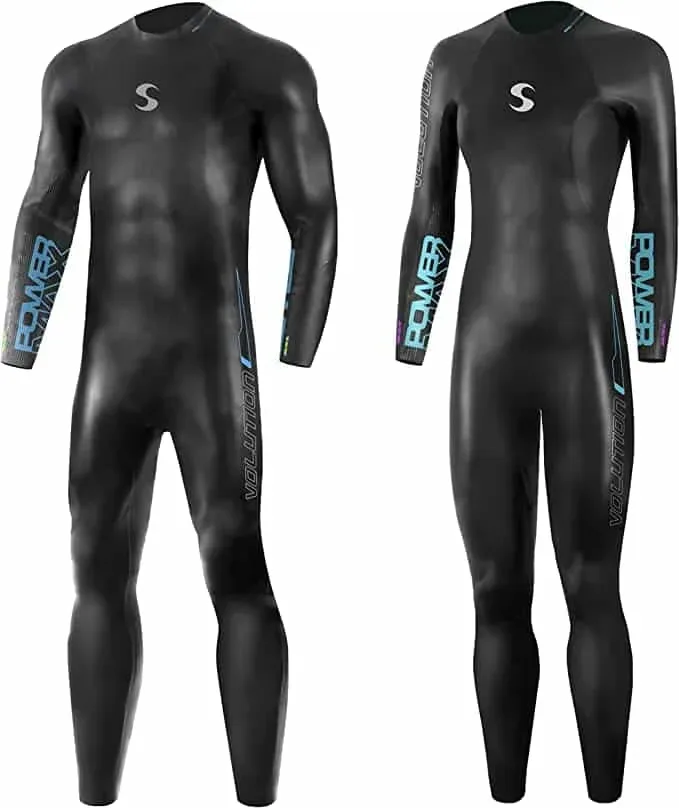
I’ve been on the hunt for the best triathlon wetsuit, and after trying on a multitude of options, the Synergy Triathlon Wetsuit 3/2mm stood out from the crowd. It’s a second skin – the material is excellent, high-quality neoprene that is impressively flexible and stretches snugly to fit your body. Even though the sizing seemed challenging at first, thanks to Amazon’s excellent customer service and return policy, I found my perfect fit after a few tries.
While the size chart could be improved for accuracy, with a bit of patience, I can assure you that the wetsuit feels fantastic once you find the right size. I followed the recommendation to choose by weight, ended up needing a size larger than expected, but the customer support was quick to accommodate the change.
One of the defining features of this wetsuit is its performance. The feel and flexibility are superb, both in and out of the water. It provides a pleasing warmth in water close to 20c, and although it gets a bit chilly closer to 15c, it’s bearable. The suit feels well-made, and even after several weeks of regular use, I’ve noticed no rips or dings, a testament to its durability.
The understated design is another positive – no excessive logos or branding. It’s a good looking, efficient piece of gear that seems built to last.
However, it’s not all perfect. One downside was noticeable wear in the armpit area after some weeks of use. That said, the seller was very responsive and helpful in resolving the issue, indicating a commitment to customer satisfaction.
In summary, the Synergy Triathlon Wetsuit 3/2mm is a great choice if you’re looking for a high-quality, high-performance triathlon wetsuit. With a little patience for the sizing and some care in use, this could be the best triathlon wetsuit you’ve ever owned.
Buying options: Buy at Amazon.com for $199.95, Buy at Amazon.co.uk for £179.95
Synergy Endorphin Full Sleeve Smoothskin
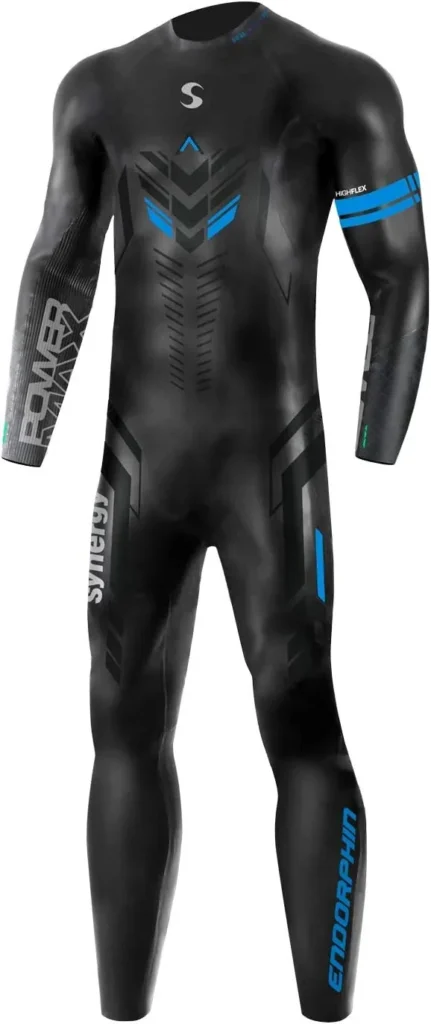
- Buy at Amazon.com for $340.00 (5mm/3mm Men)
- Buy at Amazon.com for $340 (5/3mm Women)
I’ve tested my fair share of gear, but the Synergy Endorphin Full Sleeve Smoothskin wetsuit is a standout choice. To provide some context, I stand at 6’1 and weigh 205 lbs. Being fit and possessing broader shoulders and a larger chest, I initially went for the L1, as per the sizing chart. Admittedly, the first try-on was a challenge, and the zip felt impossible to close up. But with some twisting and pulling and reading the instructions thoroughly, I managed to secure it after a significant effort.
I’ve tested my fair share of gear, but the Synergy Endorphin Full Sleeve Smoothskin wetsuit is a standout choice. To provide some context, I stand at 6’1 and weigh 205 lbs. Being fit and possessing broader shoulders and a larger chest, I initially went for the L1, as per the sizing chart. Admittedly, the first try-on was a challenge, and the zip felt impossible to close up. But with some twisting and pulling and reading the instructions thoroughly, I managed to secure it after a significant effort.
Initially, the neck area felt uncomfortably tight. But taking the advice of the company representative, I tried it out in water, and to my surprise, the suit loosened up considerably. Over time, I found that leaving the zipper zipped up 4-6 inches from the bottom made it much easier to put on and zip up. In terms of performance, the Endorphin exceeded expectations. It kept me warmer in cold water and allowed for exceptional flexibility while swimming. The additional buoyancy was a significant advantage, especially for open-water swims.
While the Synergy Endorphin is my first full wetsuit, I do own a half version for comparison. If I were to choose again, I’d undoubtedly opt for the full suit. The extra coverage makes a remarkable difference, especially when swimming in colder water, extending the swimming season significantly.
Fit-wise, the L1 was perfect for my build. Although I noticed a slight decrease in the range of motion (ROM) in my arms and a moderate reduction in knee bending, the overall ROM was more than satisfactory. Plus, the extra buoyancy made up for any minor issues. After a few swims, I found it to be one of the best triathlon wetsuits on the market.
While I can’t compare the Endorphin with more expensive wetsuits, I can confidently say it offers a fantastic balance of protection, flexibility, and value for money. The construction quality and feel of the material are top-notch, and the buoyancy has been a game-changer in my swimming experience.
In short, the Synergy Endorphin Full Sleeve Smoothskin has earned my highest recommendation for anyone keen on extending their open-water swimming season or preparing for an upcoming triathlon. It delivers on all fronts, combining comfort, durability, performance, and value in one sleek package.
Synergy Triathlon Wetsuit 3/2mm no-sleeves
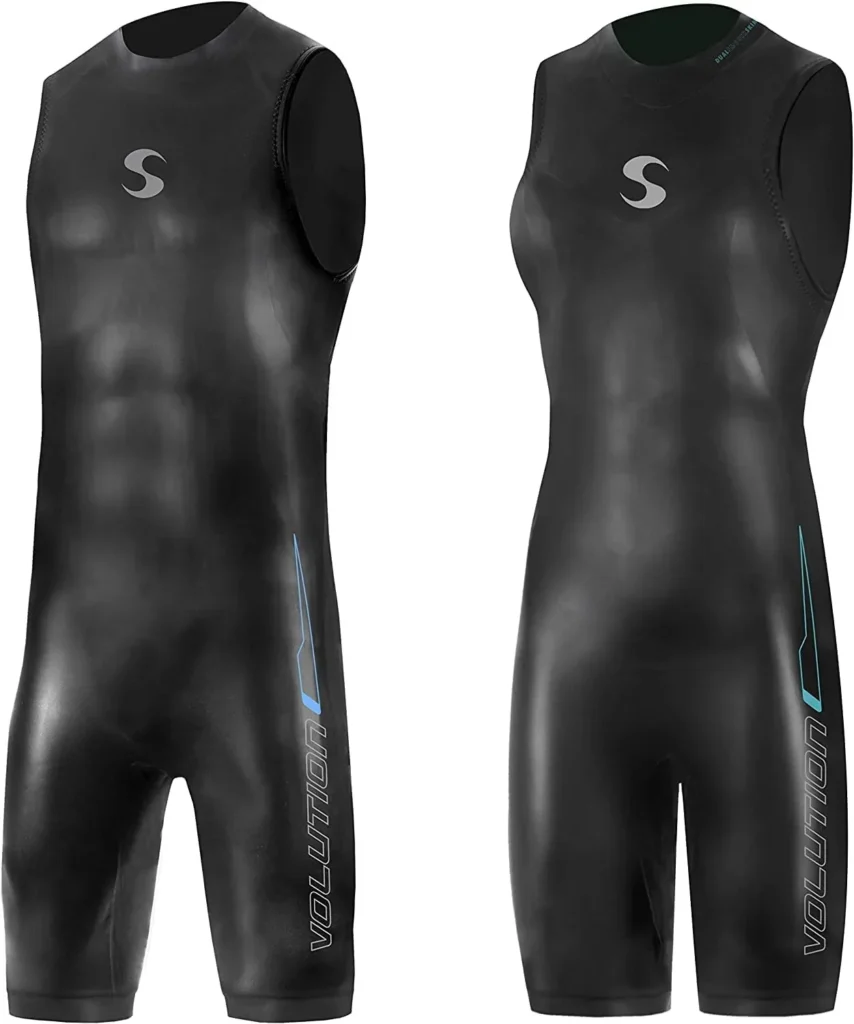
The Synergy Triathlon Wetsuit 3/2mm stands out as one the best triathlon wetsuit I’ve tried so far.
The first thing that struck me about this wetsuit was the quality of the materials used. The suit is well-made with excellent neoprene, which feels solid and durable. Swimming in it was a pleasure as it felt sleek and fast in the water. The fit was pretty accurate for me, and I had no issues with leaks or cold water intrusion.
I’d like to note that the suit seemed to run a bit small. I’m an athletic 6 feet tall, weighing around 207 pounds and the L3 size was perfect for me. The Synergy sizing guide suggested L1 or L2, but those were too tight around my swimmer’s shoulders. So, if you’re planning to get one, consider ordering a size larger.
While the suit is mostly impressive, it’s not without its flaws. The stitching, in particular, gave me a bit of trouble. The suit I received had a stitching issue in the groin area, and one of the leg baffles tore off at the stitching. While these problems were an inconvenience, I believe they aren’t reflective of the overall quality of the suit and could have been isolated incidents.
Another concern was the zipper. It was always stuck 3/4 way, and the end of the zipper line had a confusing design with a velcro point wrapped in a piece of fabric. When the fabric piece was lost, the velcro end would randomly scratch my skin.
On the brighter side, the customer service was responsive when I decided to return the L1 and L2 sizes, which was an easy process as long as the tags were intact and the suit was not wet. I also appreciate the fact that Synergy has a robust return policy, and I was able to return and exchange suits that didn’t fit well.
In conclusion, I believe that the Synergy Triathlon Wetsuit 3/2mm is the best triathlon wetsuit I’ve tried. While it does have a few issues, its strengths, like the quality of the material and the overall comfort, far outweigh these. I am a fan of Synergy and have found their products to offer excellent quality at a fair price. With this wetsuit, they have another satisfied customer in me.
Buying Options: Amazon.com for $159.95, Amazon.co.uk for £159.95
O’Neill Men’s O’Riginal 2mm:
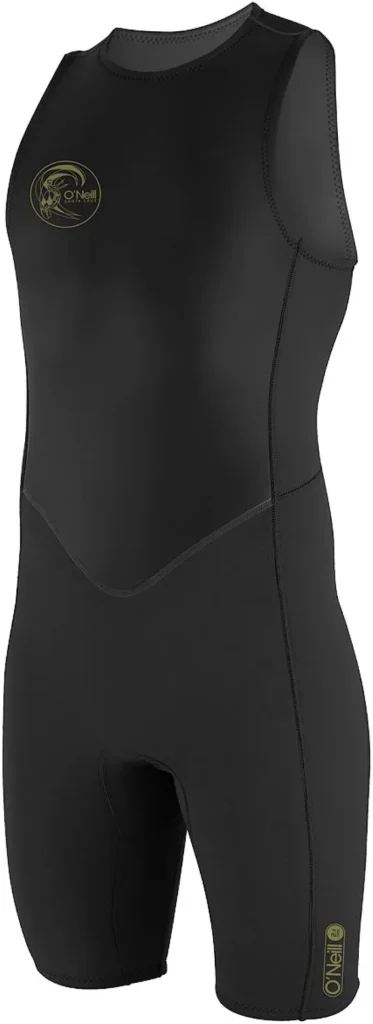
Overall, the O’Neill Men’s O’Riginal 2mm wetsuit provides excellent value for its price. It fits well, offers good buoyancy, and doesn’t cause rashes even during extended water sessions. Despite some minor issues such as a snug shoulder fit and less insulation around the torso, the wetsuit’s quality, comfort, and functionality make it a solid choice for various water activities. For those seeking affordable yet high-quality watersports gear, this wetsuit is a great choice.
In my personal experience, the O’Neill Men’s O’Riginal 2mm wetsuit is a great value for the price. Being 6’3″, and around 215lbs, I found that the 2x size was a perfect fit for me. The suit is comfortable and well made, definitely something I would attribute to O’Neill’s reputation for quality products.
One of the greatest advantages I noticed while wearing this suit was that it didn’t rash me up like board shorts or a neoprene shirt would during long, warm water sessions. Although I noticed a slight snugness on the shoulders that did cause a minor sore after consecutive days of use, the overall experience remained quite comfortable.
Additionally, I appreciated the back zipper design over the usual shoulder velcro found on many similar products. It was non-restrictive, and it didn’t overheat even after long sessions in warm water, which ranged from 65-70 degrees Fahrenheit.
While the suit seemed to wear out after a few years of heavy use, it’s important to note that this was with usage around 100 days a year, a considerable amount for any watersports equipment. The suit stretched well and remained tight enough to prevent water from rushing in while paddling.
However, I did notice that while the suit was comfortable for swimming, it wasn’t as warm around the torso as I would have liked. During my participation in the Escape from Alcatraz swim, I found that seawater flowed around the torso area quite freely. That said, the suit was perfect for other water activities like surfing.
Despite these few minor shortcomings, I would say that the suit is indeed the real deal. It fits well, offers good buoyancy, and is easy to use, making it an excellent choice for activities such as jet skiing. And although it may not provide complete insulation, it’s a great option for those looking for lower back and thigh protection, especially in warmer waters.
In summary, while the O’Neill Men’s O’Riginal 2mm wetsuit may not be perfect for every scenario, it is a great value for money product that is well-made, comfortable, and practical for a variety of water-based activities.
Buying options:
Triathlon Wetsuit Buoyancy Shorts
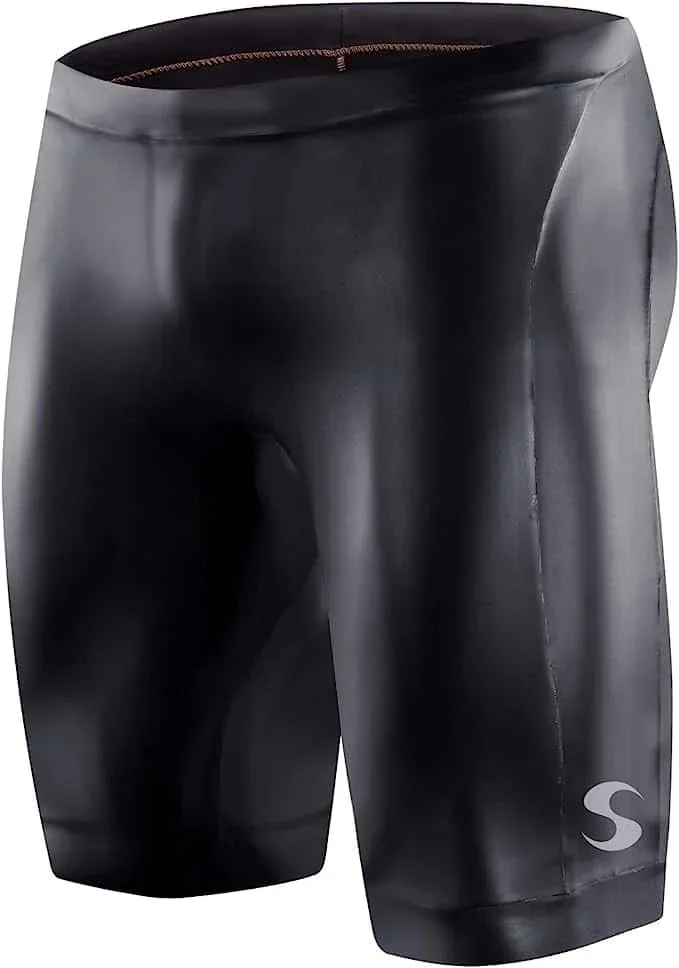
These buoyancy shorts provide an excellent balance of comfort, functionality, and durability. They significantly improve your swimming performance, are resilient to elements like chlorine, and aid in better body positioning in the water. However, minor durability issues and a thickness that may not suit beginners are points to consider. Overall, these shorts promise a long-term return on investment that outweighs their slightly higher upfront cost.
In my experience, these buoyancy shorts are a worthy purchase for any swimmer, whether professional or just beginning. They are thin yet effectively buoyant, providing the ideal balance between comfort and function. What stands out for me is how they’ve enhanced my swimming performance, with a notable improvement in my lap times. This is largely due to the fact that these shorts help keep my body better aligned in the water and my legs from dragging. In a nutshell, the shorts have taken me a step closer to being competitive with fellow swimmers, without needing to use a pull buoy anymore.
From a fit and comfort perspective, these shorts are almost exemplary. They are snug without feeling overly tight. The drawstring feature is a bonus, ensuring the shorts stay in place during my swims. The unisex design also makes these shorts suitable for anyone, with sizing that seems to work well for both men and women. While my shorts are from the men’s range, I’ve noticed that they fit perfectly even for a female like me.
These shorts are more than just buoyant. They’re also surprisingly resilient to elements like chlorine and salty water. After using them for quite some time, they show little to no signs of wear and tear. Moreover, they don’t seem to leak water much, which is a testament to their superior quality and fit.
When it comes to enhancing my swimming technique, these shorts have indeed been a revelation. Not only have they improved my stroke and kick techniques, but they have also made me more aware of my body positioning in the water, particularly my hips. It’s almost like having a coach by your side, correcting and improving your technique one swim at a time.
However, not all experiences with these shorts have been smooth sailing. There have been minor issues regarding the product’s durability, with some instances of the glue from the junctions separating. That’s a setback, given the price point of these shorts. The thickness, while offering good buoyancy, may not be the best fit for beginners looking for a higher degree of support in the water.
Despite these minor drawbacks, I would still highly recommend these shorts. They offer superior warmth and flexibility, and feel like they will last for years. Sure, there are cheaper alternatives out there, but in the long run, these shorts promise to give you your money’s worth.
Buying options: Amazon.com for $149.95
Factors to Consider When Buying a Triathlon Wetsuit
Material and Construction
Triathlon wetsuits are predominantly made from a synthetic rubber called neoprene, renowned for its excellent insulating properties. However, not all neoprene is created equal. High-quality neoprene will have a high degree of flexibility and durability, which will ensure your movements aren’t restricted during your swim and that the wetsuit withstands the rigors of multiple races.
Another crucial aspect of a wetsuit’s construction is its seams. Seams should be glued and blind-stitched to prevent water seepage, ensuring that you stay warm and dry during your swim. Some wetsuits even include reinforced panels in high-wear areas, such as the knees and rear, for added durability.
Thickness and Flexibility
Wetsuits come in a variety of thicknesses, typically ranging from 1mm to 5mm. The thickness you choose depends on the water temperature you’ll be racing in. Thicker wetsuits provide more insulation and buoyancy, making them ideal for colder conditions.
However, they also restrict movement slightly, which could impede your swim strokes.
Flexibility, on the other hand, is paramount for efficient movement in the water. High-quality wetsuits will have flexibility panels in key areas, like the shoulders and arms, to ensure you can complete your swim strokes unhindered.
Fit and Comfort
The fit of your wetsuit could make or break your race performance. It needs to be snug enough to prevent water from flooding in, but not so tight that it restricts your movements or breathing.
Pay close attention to the manufacturer’s sizing guide when selecting a suit, and if possible, try on several different sizes and brands to find the best fit for your body shape.
Comfort is another crucial factor.
This includes everything from the way the collar sits against your neck to the range of motion in the shoulders and the length of the legs and arms.
Uncomfortable wetsuits can chafe, restrict movement, and generally distract you from your race.
Price and Value
As with most things, you get what you pay for with triathlon wetsuits.
Higher-end models come with features like superior neoprene, advanced seam construction, and flexibility panels. While these features certainly provide an advantage, not everyone needs a top-of-the-line suit.
If you’re a beginner or only compete in a few races a year, a budget-friendly option might serve you well. Just ensure it fits well and is comfortable.
As you become more involved in the sport, you can invest in a more advanced model.
Ease of use
The nature of a triathlon means you’ll need to transition from swimming to biking quickly. As such, you’ll want a wetsuit that’s easy to remove.
Look for designs that include a sturdy, high-quality zipper that can be pulled down with one swift movement.
Some models even have zippers at the ankles and wrists for even faster removal.
Tips for Caring for Your Triathlon Wetsuit
Proper Maintenance for Longevity To get the most out of your wetsuit, proper care is vital. Always rinse your wetsuit with fresh water after every use to remove salt, chlorine, and other potentially damaging substances.
Allow it to air dry away from direct sunlight, which can degrade the neoprene over time.
Store your wetsuit on a wide hanger to prevent creases and damage to the material. If you spot any minor tears or holes, repair kits are available.
However, for significant damage, you might want to consider professional repairs or even a replacement.
The most common mistakes when it comes to wetsuit care relate to storage and exposure. Never leave your wetsuit in direct sunlight for extended periods, as this can cause the neoprene to become brittle and crack.
Also, avoid folding or tightly rolling your wetsuit. Instead, hang it up or lay it flat to prevent creases.
Brands and Models
Leading brands in the triathlon wetsuit market each bring unique design philosophies and materials to their products. For example, brands like ROKA, Zone3, and TYR have made their name with high-quality, performance-focused wetsuits.
ROKA’s Maverick X wetsuit is a prime example of their philosophy of minimal restriction and maximum buoyancy. It’s designed with their patented Arms-Up™ technology for superior shoulder flexibility and features strategically placed buoyant panels to ensure the most efficient swim position.
On the other hand, Zone3’s Aspire wetsuit uses premium SCS Yamamoto fabrics to deliver a buoyant, smooth, and flexible swim. It’s recognized for its high flexibility around the shoulders and arms, providing comfort over long distances.
TYR, with their Hurricane Freak of Nature wetsuit, combines a range of technologies such as range-of-motion zones, speed wrap paneling, and quick-release ankle cuffs to aid fast transitions. They prioritize speed, flexibility, and buoyancy to offer an advantage in the water.
Gender-Specific Triathlon Wetsuits
Men’s and women’s wetsuits primarily differ in terms of cut and fit to accommodate different body shapes. Women’s suits may offer more room in the chest and hips, while men’s suits may be broader in the shoulders. The performance should be equivalent between the two, assuming a proper fit. The main goal is to ensure every athlete, regardless of gender, can find a wetsuit that offers a comfortable fit and allows unrestricted movement.
Triathlon Youth Wetsuits:
Youth wetsuits are generally designed with additional buoyancy, which helps young and less experienced swimmers stay afloat more easily.
They also tend to have more robust construction to withstand the rough and tumble often associated with kids and sport. As with adult suits, the fit is key and parents should look for a suit that is snug but not restrictive.
Triathlon Wetsuit Regulations:
Wetsuit regulations vary by race and organization. For example, the International Triathlon Union states that wetsuits can be used in water temperatures up to 24.5°C for races under 3000m. For Ironman races, wetsuits are permitted if the water temperature is below 24.5°C for pros and below 28.8°C for age-group athletes. Beyond temperature, there may be restrictions on wetsuit thickness (usually no more than 5mm) to prevent excessive buoyancy.
Training in a Triathlon Wetsuit
Training in a wetsuit can help athletes acclimate to the feel and buoyancy of the suit. However, frequent use can accelerate wear and tear, so balance is key. It’s also different from racing in that it’s best to train in a variety of conditions (both with and without the wetsuit) to prepare for different race day scenarios.
Alternative options
In warmer climates where wetsuits aren’t permitted, “swimskins” are an alternative. These are made from water-repellent fabric and fit tightly to the body to reduce drag. While they lack the buoyancy of wetsuits, they can still offer a speed advantage over regular swimwear.
Custom Triathlon Wetsuits
Certain brands offer bespoke wetsuit services, where a wetsuit is made specifically for an individual’s measurements. This can ensure a perfect fit, which can enhance comfort and performance. However, this service is typically more expensive than off-the-rack options.
Triathlon Wetsuit Accessories
Accessories like hoods, gloves, and boots can provide extra warmth in cold conditions. Transition mats can help keep feet clean for the bike and run stages. While not essential for all athletes, they can provide additional comfort and convenience.
Read: The best triathlon wetsuit repair kit
Read: The Ultimate Guide to the Best Triathlon Swim Goggles in 2023
Wetsuit vs. No Wetsuit Races:
In races where wetsuits aren’t permitted due to warm water temperatures, strategies might need to change. Athletes may need to work on their swim technique and positioning in the water, as they won’t have the added buoyancy of a wetsuit to rely on. Training in these conditions is essential to prepare for this scenario.
This extensive exploration into the world of triathlon wetsuits should give everyone, from novices to seasoned triathletes, a comprehensive understanding of this essential piece of gear. As the industry continues to evolve, so will the technology and design of wetsuits, keeping us on the lookout for the next game-changer.
Safety Features
Safety in the water is crucial, and some triathlon wetsuits incorporate features to increase visibility and flotation. Bright colors or reflective patches may be used on the back and arms to enhance visibility. Some brands integrate extra flotation into their designs, often in the form of buoyant panels, which can be a real aid to weaker swimmers.
Innovation and Technology
Recent advancements in wetsuit technology have been focused on improving buoyancy and reducing drag. For example, Huub’s Albacore wetsuit uses a unique constrictor system to compress non-essential muscles and divert energy to those needed in swimming. Furthermore, 3D body-mapped and heat-formed fit technology is becoming more common, ensuring the suit fits as closely to the athlete’s body as possible, reducing drag and improving performance. We can expect the evolution of technology to continue pushing the boundaries of wetsuit performance and comfort.
Environmental Impact
The wetsuit industry has been under scrutiny for its environmental impact, primarily due to the use of neoprene, a petroleum-based material. Some brands like Patagonia and Picture Organic are pushing towards more sustainable alternatives like natural rubber. Additionally, recycling programs are being developed by organizations like The Wetsuit Recycling Company, which takes old wetsuits and turns them into yoga mats, can holders, and other products.
Frequently Asked Questions about Triathlon Wetsuits
Do you need a different wetsuit for different triathlon distances?
Generally, no. The wetsuit’s purpose is to keep you warm and buoyant during the swim portion of the triathlon, regardless of the distance of the race.
Can you use a surfing wetsuit for triathlon?
While it’s possible to swim in a surfing wetsuit, they’re typically not designed for the long-distance, high-intensity swimming involved in a triathlon. Triathlon wetsuits are specially designed for flexibility, efficiency, and speed in the water.
How often should you replace your triathlon wetsuit?
This depends on how frequently you use it and how well you care for it. With proper care and moderate use, a good-quality wetsuit should last for several years.
How should a triathlon wetsuit fit?
Your wetsuit should fit snugly, like a second skin, but it should not restrict your movements or breathing. If it’s too loose, it will allow water to seep in, which will slow you down and make you colder in the water.
What is the correct way to put on a triathlon wetsuit?
Start by pulling the legs of the wetsuit up to your waist, one leg at a time, making sure the knee pads align correctly. Pull up the torso, get your arms in, and adjust the suit so it sits correctly on your body before pulling up the zipper. A plastic bag can help your feet and hands slide through the tight sections more easily.
How can I tell if my wetsuit is too small?
If the wetsuit is restricting your movements or breathing, causing discomfort, or if it’s excessively difficult to put on, it’s likely too small. A well-fitted wetsuit should be snug but not overly tight.
Can a triathlon wetsuit be used for open water swimming?
Yes, triathlon wetsuits are ideal for open water swimming. They provide warmth, buoyancy, and are designed to allow for efficient swimming.
How should I clean my triathlon wetsuit?
Rinse your wetsuit with fresh water after every use to remove salt, chlorine, and other substances. Avoid using detergents or bleach, as these can damage the neoprene material. Allow it to air dry away from direct sunlight.
How do I know when it’s time to replace my wetsuit?
If you start noticing the neoprene becoming thin, discolored, or brittle, or if the wetsuit has developed irreparable tears, it might be time to consider a replacement. A well-maintained wetsuit should last for several years.
Can I use a rental wetsuit for my first triathlon?
Absolutely! Rental wetsuits are a great option for beginners who are trying out the sport. However, as you become more serious about triathlon, investing in your own wetsuit can offer advantages in terms of fit, comfort, and familiarity.
